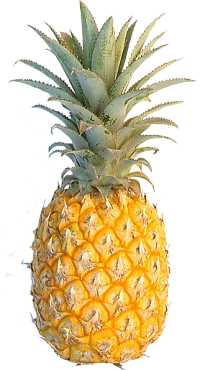|
Ananas comosus (Pineapple) Life
> eukaryotes >
Archaeoplastida >
Chloroplastida
>
Charophyta > Streptophytina > Plantae (land plants)
> Tracheophyta (vascular plants) > Euphyllophyta > Lignophyta (woody plants)
> Spermatophyta (seed plants) > Angiospermae (flowering
plants) > Monocotyledons > Order:
Poales > Family:
Bromeliaceae
The pineapple originates from South America and is a cultigen
species produced in prehistorical times by South American Indians through
hybridisation of two wild species and selection for beneficial traits of fruit
size and quality. Pineapples are cultivated as clones with the Cayenne clone
being the most popular. They contain protein-digesting enzymes called
bromelains, which means that if you add fresh pineapple to jelly, it will not
set, and pineapple added to marinades will help tenderise the meat.
 |
Pineapple is a cultigen
species, throught to have originated from hybridization of two wild species:
Ananas bracteatus and Ananas fritz-muelleri. These two species have
indigenous distributions in Paraguay and southern Brazil. The wild species have
smaller fruit than Ananas comosus and are full of hard seeds.
The pineapple fruit is an inflorescence of flowers that has
fused into a single fleshy mass with the core being the main stem. Domestication
of Pinapple was undertaken in prehistorical times by South American Indians,
where they selected fruit for size and quality. They could propagate plants
vegetatively by planting the cut-off top of the pinapple. The selection process
resulted in mutant clones that were self-incompatible and developed fruit
parthenogenetically - in other words pollination was ineffective within clones
and unnecessary as the fruit could develop without it. If different clones are
grown in proximity to one another, then pollination between clones is effective
and results in fruit with hard seeds. Thus, clones are not sexually sterile and
to prevent pollination (and therefore seed production) they need to be grown
away from one another. Pineapple farmers therefore need to talk to one another:
if the one farmer were to grow one particular variety of pineapple and his
neighbour another variety, then there would be a disaster as many of the fruit
would be seeded from having been pollinated successfully.
Domesticated pineapples gradually spread by people from
their origin northwards into Central America, southern Mexico and the Caribbean
(West Indies). Thus it was that the first encounter of Europeans with Pineapples
was by Columbus in 1493 on the island of Guadeloupe in the West Indies. During
the 1600's and 1700's pineapples were spread worldwide by Portuguese and Dutch
ships. Pineapples started being cultivated in greenhouse in Europe not long
after 1700 and were regarded as a huge luxury. The most well known clone is
Cayenne, which was introduced from French Guiana to France in about 1820 from
whence it was spread rapidly around the world.
|
Because a pineapple crop consist of a single clone, it
means that there is more uniformity and predictability. In addition, farmers are
able to synchonise flower initiation and hence fruit production by spraying the
crop with the plant growth substance auxin. This makes harvesting a lot easier
because the fruit are all ready for picking at about the same time. Pineapples
need to be picked when ripe because they do not contain a reserve of starch that
is converted to sugars after picking, as is the case in many other fruits,
Instead, starch is stored in the stem and after conversion to sugar, moves into
the fruit.
Nutritionally, a pineapple contain reasonable levels of
Vitamins C, A and E. It also has protein-digesting enzymes called bromelains,
which means that if you add fresh pineapple to a jelly, the jelly will not set
because the bromelains break down the gelatin. It also has strange effects on
other protein-containing foods such as yoghurt and cottage cheese. Bromelains
are destroyed by heat and hence tinned or boiled pineapple can be added to e.g.
jelly without any problems because the bromelains have been deactivated through
heating. Pineapple is often used in marinades because the bromelains tenderise
the meat although exposing the meat to pineapple for too long makes it too soft.
Within southern Africa, pineapples are cultivated mainly in
the Western Cape.
Ecological relationships
Acetobacter diazotrophicus
Bacteria
Acid-producing, nitrogen-fixing bacteria that are found in the fruit of
pinapple plants. |
|
|
|
References
-
Anon. 2002. Encyclopedia of Foods. A Guide
to Healthy Nutrition. Academic Press, San Diego, California.
-
Sauer, J.D. 1993. Historical geography of
crop plants - a select roster. CRC Press, Boca Raton, Florida.
-
van Wyk, B.-E. 2005. Food Plants of the World -
Identification, Culinary Uses and Nutritional Value. Briza, Pretoria.
|
